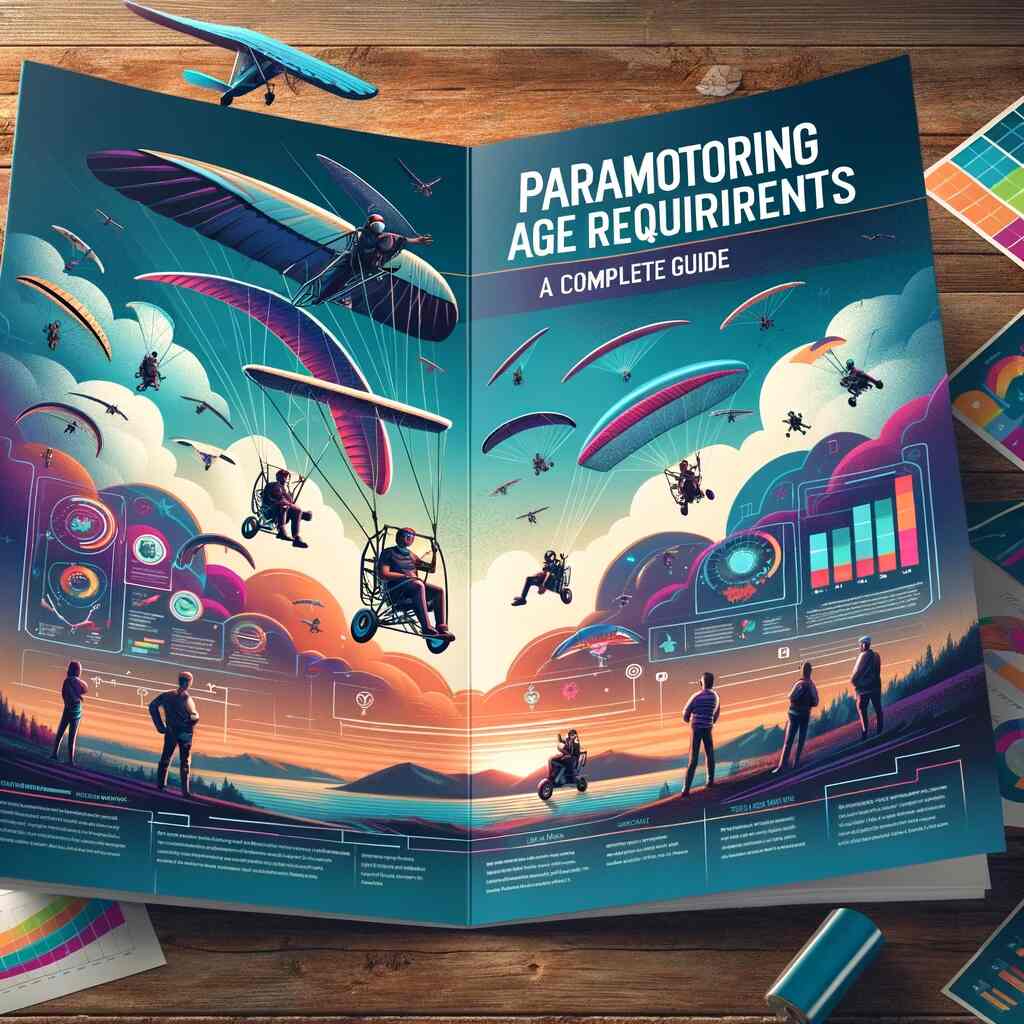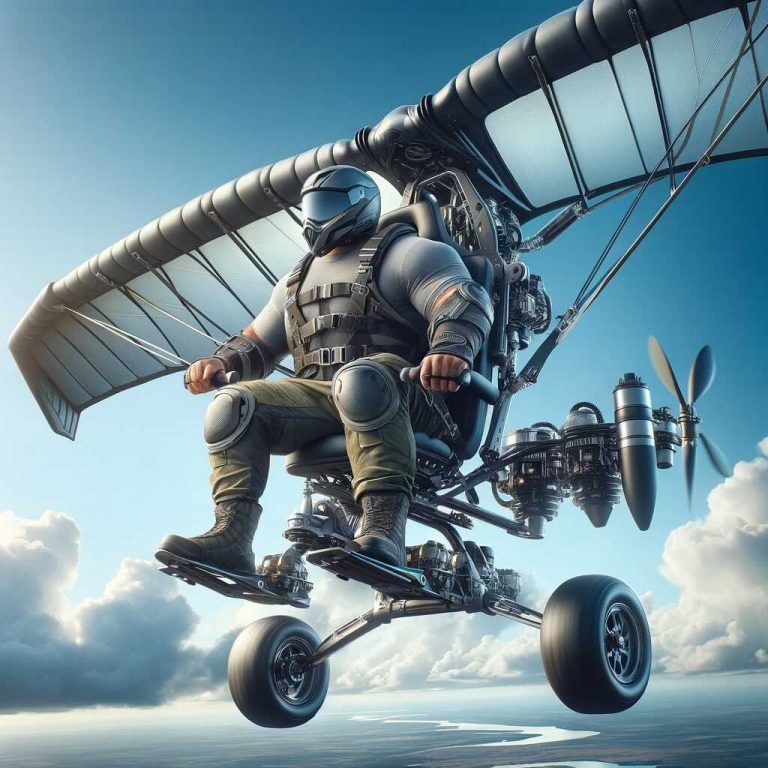Paramotoring, a thrilling and adventurous sport that combines the excitement of flying with the freedom of motorized paragliding, has gained popularity worldwide. As more and more people become interested in this exhilarating activity, it’s essential to understand the age requirements and regulations associated with paramotoring to ensure safety and compliance. How old do you have to be to fly a paramotor?
Paramotoring has no official age restrictions, but most training schools don’t enroll students under 14 and there’s no upper age limit. Be prepared physically to carry a 57 pounds/26kg paramotor on your back.
However, there are typically 3 crucial age-related factors that come into play: minimum training age, minimum solo flight age, and passenger age restrictions. Keep reading down below!
Understanding Paramotoring
Before we dive into the age requirements, let’s take a moment to understand what paramotoring is and why it has become such a beloved pastime for adventure seekers.
What Is Paramotoring?
A paramotoring is a form of powered paragliding that combines a lightweight motor, typically mounted on the pilot’s back, with a paraglider wing. This unique setup allows individuals to take off and land on their feet, providing a more accessible and portable way to experience the thrill of powered flight. Paramotoring offers a sense of freedom and adventure like no other, allowing pilots to soar above the landscape with minimal equipment.
Why Is Paramotoring So Popular?
Paramotoring has gained immense popularity for several reasons:
- Accessibility: Unlike traditional aviation, paramotoring doesn’t require a runway or airport. You can take off and land from relatively small fields, making it accessible to a broader range of individuals.
- Affordability: Paramotoring is relatively more affordable than other forms of flying. The initial investment for equipment is lower, and ongoing costs are minimal compared to maintaining a traditional aircraft.
- Simplicity: The simplicity of paramotoring equipment and training means that you can be up in the air in a matter of days or weeks, rather than months or years.
- Thrill and Freedom: The sensation of flying while being exposed to the elements is a unique experience that provides an unparalleled sense of freedom and adventure.
Now that we have a better understanding of paramotoring, let’s delve into the age requirements and regulations associated with this exciting activity.
Age Requirements for Paramotoring
The age requirements for paramotoring may vary depending on your location, the governing aviation authority, and the specific training program you choose. Generally, there are three key age-related aspects to consider: the minimum age for training, the minimum age for solo flight, and any age restrictions for passengers.
1. Minimum Age for Training
Most paramotoring training programs have a minimum age requirement for participants. This is often due to safety concerns, as younger individuals may not have the physical strength, coordination, or maturity required to operate the equipment safely.
The minimum training age for paramotoring typically ranges from 14 to 16 years old. However, it’s essential to check with your chosen training school or instructor for their specific age requirements, as they may vary.
2. Minimum Age for Solo Flight
Once you’ve completed your paramotoring training, you’ll need to meet a minimum age requirement to fly solo. This age requirement is typically higher than the minimum training age, as it considers the pilot’s readiness to handle the responsibilities and potential risks associated with independent flying.
The minimum age for solo paramotoring flight often ranges from 16 to 18 years old. Again, it’s crucial to verify this requirement with your instructor or the relevant aviation authority in your country.
3. Age Restrictions for Passengers
If you plan to take passengers with you on your paramotoring adventures, there may be age restrictions to consider. These restrictions are in place to ensure the safety of passengers, especially when flying with children or individuals who may not be physically or mentally prepared for the experience.
Age restrictions for passengers typically range from 14 to 18 years old, depending on the jurisdiction and the pilot’s experience level. It’s essential to check the specific regulations in your area if you intend to take passengers on your paramotoring flights.
Factors Influencing Paramotoring Age Requirements
Several factors contribute to the variation in paramotoring age requirements across different regions and training programs. Understanding these factors can help you navigate the age-related regulations more effectively.
1. Regulatory Authority
Paramotoring is subject to regulations set by the aviation authority in your country. In the United States, for example, the Federal Aviation Administration (FAA) oversees aviation activities, including paramotoring. Different countries may have their own aviation authorities with unique age requirements.
To determine the exact age requirements for paramotoring in your area, it’s crucial to consult the relevant aviation authority’s guidelines or speak with an experienced instructor who is well-versed in local regulations.
2. Training Program
The paramotoring training program you choose can influence the age requirements you must meet. Some training programs may have more stringent age restrictions to ensure the safety of their students, while others may be more lenient.
Before enrolling in a training program, research multiple options, inquire about their age requirements, and choose one that aligns with your age and experience level.
3. Instructor Discretion
In some cases, an experienced paramotoring instructor may use their discretion when determining a student’s readiness for training or solo flight. While there may be a minimum age requirement, an instructor may assess an individual’s maturity, physical capabilities, and aptitude for flying before allowing them to participate in training or fly solo.
It’s essential to maintain open communication with your instructor and discuss any concerns or questions related to age requirements during your paramotoring journey.
Preparing for Paramotoring at a Young Age
If you’re passionate about paramotoring and meet the minimum age requirements in your area, you can take steps to prepare for this exciting adventure while you wait to reach the necessary age milestones.
1. Research and Education
Start by educating yourself about paramotoring. Read books, watch videos, and engage with online paramotoring communities to gain knowledge about the sport. Understanding the principles of flight, equipment, and safety procedures will give you a head start when you’re old enough to begin formal training.
2. Physical Fitness
Paramotoring requires a reasonable level of physical fitness. To prepare for your future training, focus on maintaining a healthy lifestyle, staying physically active, and building strength and endurance. Regular exercise can improve your overall fitness and help you excel when you eventually begin your paramotoring journey.
3. Find a Mentor
If you’re enthusiastic about paramotoring and want to learn more, consider finding a mentor or experienced pilot who can guide you through the basics. While you may not be able to officially train or fly solo, learning from an experienced individual can be both informative and inspirational.
Overcoming Age Restrictions
For those who are determined to pursue paramotoring despite age restrictions, there are some potential avenues to explore. Keep in mind that these options may not be available in all regions, and their legality and safety should be carefully considered.
1. Parental Consent
In some cases, paramotoring schools or instructors may consider allowing younger individuals to train or fly solo with parental consent. If you are below the minimum age requirement but believe you are physically and mentally prepared for paramotoring, discuss the possibility of parental consent with your chosen instructor or training program.
2. International Opportunities
If the age restrictions in your country are particularly strict, you may explore opportunities to train or fly in a location with more lenient regulations. Some countries have lower age requirements for paramotoring, and international training programs may be an option for those who are determined to pursue their passion.
3. Advocacy and Regulations
If you are passionate about paramotoring and believe that age restrictions should be reconsidered, you can become an advocate for change. Engage with local aviation authorities and paramotoring organizations to voice your concerns and advocate for more inclusive age requirements. Keep in mind that changing regulations can be a lengthy and challenging process.
Conclusion
Paramotoring is an exhilarating and accessible adventure sport that allows individuals to experience the joy of powered flight. Understanding the age requirements associated with paramotoring is crucial for both safety and compliance. While age restrictions may vary depending on your location, training program, and the regulatory authority in your country, it’s essential to respect and adhere to these requirements.
If you are below the minimum age for paramotoring training or solo flight, use this time to prepare physically and mentally for your future adventures. Stay informed, maintain a healthy lifestyle, and consider finding a mentor or experienced pilot to guide you on your journey.
For those who are passionate about paramotoring but face age-related challenges, explore potential options such as parental consent or international opportunities. Additionally, consider becoming an advocate for change within the paramotoring community to help shape more inclusive age requirements in the future.
Ultimately, paramotoring offers a unique and thrilling experience, and with the right preparation and adherence to age requirements, you can embark on this exciting adventure safely and responsibly.




